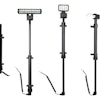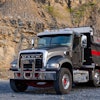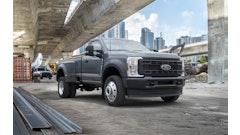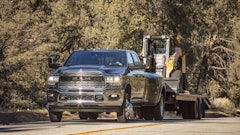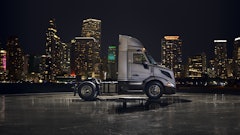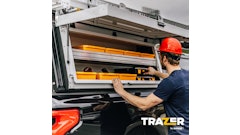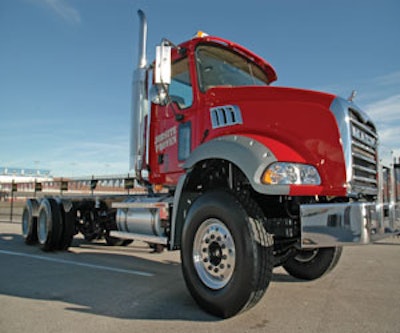
Mack Trucks, Inc. experienced strong demand for its Granite vocational trucks. Steve Ginter, marketing manager for vocational products, partially credits the truck's light weight for this popularity. "We were able to improve profitability by carrying more payload," he states.
Granite was initially offered only in axle forward configurations. These configurations meet the demands of many customers who are governed by bridge laws and other weight and length restrictions. But there are regions where local laws and regulations favor the use of axle back configurations. In some states, and particularly in Canada, the laws governing roadway use are such that having the front axle set back makes it possible to legally carry more payload. The axle back position also results in a shorter overall wheelbase, making it easier to maneuver around tight jobsites.
Mack Trucks previously filled the niche for the axle back configuration with its DM model. "The DM is still in production and now it is 40 years old," says Ginter.
A new generation axle back rolls out
To meet the demands of customers who desire an axle back configuration in a modern, lightweight chassis, Mack recently unveiled the Granite Axle Back.
The backbone of this truck is the company's vocational Cornerstone chassis. "The rails are 300mm tall. That puts them about a 1/2-in. taller than a Granite axle forward rail and about 1/2-in. lower," says Ginter. "So these are very wide rails."
The rails are offered in 8-, 9.5- and 11.1mm thicknesses with a 90mm flange, as well as an 11.1mm with a 105mm flange. Rail reinforcement liners are also available. "It gives customers the choice to have either a large single rail or two rails," says Ginter. The rails are tempered to a minimum 120,000-psi yield strength.
Main crossmember packages are designed to work with specific applications, from dump and mixer service to crane service and severe duty.
The UniMax steer axles, which come standard on the new truck, feature sealed, unitized hubs specifically for vocational work.
Rated from 12,000 to 23,000 lbs., these sealed axles are virtually maintenance free.
Location of the front axle is key to an axle back truck. "We are 51.5 in. from the back of the cab to the center of the front axle," says Ginter. "That is a full 17 in. farther back than an axle forward. It improves maneuverability, and it also allows the body manufacturer to transfer maximum payload to the front axle. Of course, we have improved wheel cuts. This improved turning radius is advantageous to the customer."
The engine mounting system on the Cornerstone chassis is a proven three-point support cradle with a rubber cushioning system. This system is designed to reduce driver fatigue and increase component life by decreasing noise and vibration.
Flaring the rails up front allows the use of a larger radiator to keep the engine running cool.
Addressing the finer points
The Granite Axle Back shares the same galvanized steel cab with the other Granite trucks, but the hood incorporates a few unique features. "The headlight is brand new for vocational use and it is very bright," says Ginter. "Its Lexan covering is more durable than sealed beam headlamps." Bulbs can be changed quickly without tools.
Flexible fender extensions are positioned over the wheels to protect the hood and control splashing. The large M-shaped grille has been designed to meet future demands. "The hood slope is designed for functionality, both for visibility and for aerodynamics," says Ginter.
CTI option
Central Tire Inflation (CTI) is a factory-installed option. It allows drivers to adjust tire pressures "on the fly" to improve traction. "You can lower tire pressures to expand the tire's footprint to minimize ruts and gain extra flotation in soft sand or mud," Ginter explains.
Goodyear Displays New Technologies
The Mack Granite Axle Back trucks at the Las Vegas, NV, introduction were equipped with two new tires, the Goodyear G287 MSA and G288 MSA. In addition, Goodyear introduced DuraSeal Technology.
These tires are geared to specific applications. "Most competitors, to this point, have gone with one singular product and they have transitioned by varying tread depth," says Donn Kramer, director of Goodyear commercial tire marketing. "We're surpassing the competition with two specific designs for on- and off-road services."
The G287 MSA is primarily an on-road tire. It is designed for 80% on road and 20% off road. It replaces the G286 and features high-mileage tread compounds, an improved belt package and high-speed handling capabilities. Wet traction and a quiet ride are also claimed benefits.
The G288 MSA is primarily an off-road tire. It is designed for 80% off road and 20% on road. It also replaces the G286. This tire features a new severe service tread compound and more robust belt package for resistance to cutting, chipping and tearing. A 19% increase in tread volume delivers long tread life. The tire's open lug design also provides countless tread edges for grip.
The G287 MSA will also be available with Goodyear's new DuraSeal Technology, which repairs punctures when they occur; the G288 MSA will be available with this technology at a later date. A gel-like rubber compound sealant is built into the inner liner of the tire. It is designed to instantly seal punctures up to 1/4 in. in the tread area. "The tire casing maintains its sealing capability even after it is retread," says Steve McClellan, vice president of commercial tire systems for Goodyear. "The built-in sealant means no messy cleanup for each repair, reduced fire chamber risk during retreading and no negative impact in tire temperature, high-speed performance, durability and rolling resistance."
The DuraSeal is said to add 5 to 7 lbs. to the weight of the tire. It will be available in standard sizes by the 1st quarter of next year. While it will add 20% to 25% to the tire cost, many applications will justify the expense. We took turns driving nails into a DuraSeal-equipped tire. After more than 50 punctures, the tire had no measurable loss of air pressure.
